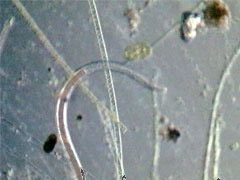Nematode
The roundworms, or nematodes, are among the most abundant multicellular animals on Earth, many of which are parasitic to plants or animals. These transparent, microscopic worms in the phylum Nematoda include free-living forms found in aquatic and terrestrial ecosystems. There are 10,000 described species, but perhaps another 100,000 that deserve taxonomic status.

Nematode Video #1
A transparent roundworm undulates and twists among filamentous debris; under oblique illumination with a playing time of 33 seconds. Choose a playback format that matches your connection speed:
Characterized by elongated bodies that taper at each end, roundworms display bilateral symmetry despite their common name. Aquatic nematodes are usually distinguished from the annelids (leeches and earthworms) by their protective cuticular sheath that helps them glide through soft sediments and submerged organic debris, and may be a remnant of a parasitic evolutionary past that required a resistance to digestive fluids. Some free-living species known as vinegar eels can tolerate the low pH of vinegar and other acidic solutions. Unlike the earthworms, the roundworms are not segmented and do not possess setae.
While freshwater nematodes are usually short (less than 10 millimeters in length), the marine parasitic Crassicauda boopis reaches an extraordinary length of greater than 150 centimeters (more than 5 feet long). This parasite is only found in fin whales (Balaenoptera physalus), where the tail of the worm is positioned in the vulval opening, and the head of the worm stretches into the host whale's kidney. Another much smaller, free-living nematode, Caernorhabditis elegans, is a favorite study subject of geneticists, and is part of the worldwide push to elucidate the genomes of the world's plants and animals, including humans. Freshwater nematodes play an important role in aquatic ecosystems and can be found in sand filters and aerobic sewage treatment plants. They are particularly abundant in secondary wastewater effluent and biofilters. Predaceous aquatic nematodes feed on other nematodes, bacteria, and small vertebrates. While ingestion of algae and diatoms has not been observed, some species of freshwater roundworms are characterized by bright yellow or green coloration associated with symbiotic algae in their guts. Some varieties of nematode crawl upon organic detritus and floc particles, move in a whip-like fashion while swimming, and can coil around objects, forming themselves into knots. In a differing behavior, many aquatic nematodes can secrete a sticky substance that anchors them to submerged substrates, enabling them to breath and feed without problems created by strong currents or turbulence. If nematodes are not present in a waste treatment system, this may be a bio-indicator that a pollutant is present, or another toxic condition has developed.
